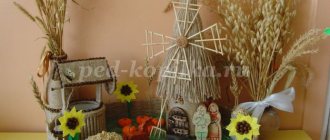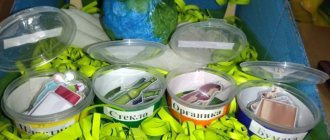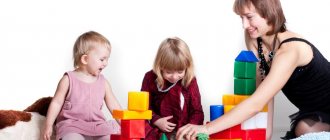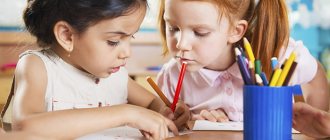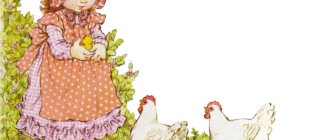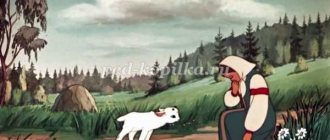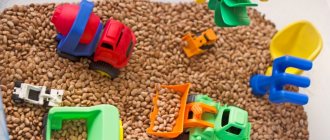Middle group. Junior preschool age. Children 4 - 5 years old
Didactic manual on FEMP “Multi-colored shirts for turtles” for children of primary preschool age 3–4 years old
This game can be used during the week of “Water Fun”
,
“Young Ecologist”
, and is also convenient to use during the summer wellness period. Introduce children to sea creatures - turtles. The game has several options. Suitable for individual...
Mathematical game for children 4–5 years old “Where is more?”
Game "Where is more?"
can be included in a
math or used by a teacher in the afternoon. The game is played with a small subgroup of children of six to seven people. Goal: Learn to compare figures in hoops by quantity; improve knowledge about...
Do-it-yourself didactic manual for teaching numeracy in kindergarten
Do-it-yourself didactic mathematical manual for preschoolers
Master class on the production of the didactic manual “Fun Counting” for individual work with preschoolers
Author : Natalya Evgenievna Khokhlova Position: teacher-defectologist Place of work: MKDOU No. 22, Miass, Chelyabinsk region Description: master class on the production of the didactic manual “Fun Counting” for individual work with preschoolers on the formation of elementary mathematical concepts. Purpose of the material: for preschool teachers and caring parents. Goal: Production of a didactic manual “Funny Counting” for individual work with preschoolers. Objectives: - learn to create teaching aids with your own hands; - develop creativity. One of the main areas of preschool education is mathematics. “A child’s element is play,” so the main principle is to teach while playing. Teaching mathematics in a playful way develops and shapes the child’s cognitive interest. To make the teaching aid “Merry Counting” we will need materials: White cardboard; Scissors; Glue; Adhesive tape.
And so do the pictures. I made a blank from pictures taken from the Internet and printed them on a color printer. I fit 4 rows of pictures on one A4 sheet. Dimensions of one row: height 4.5 cm, width (length) 28 cm. Each row contains 10 pictures. I will be happy to share my preparations with you. We cut the printed blanks into strips along the lines.
We make the same blanks (strips) from cardboard measuring 4.5 cm * 28 cm). And in addition to each workpiece, we will need two small strips measuring 0.7 cm * 28 cm.
Next, use glue to glue our row of pictures onto the cardboard blank.
If you have a sufficient number of pictures, from magazines, unnecessary books, then you can cut them out and paste them on cardboard, then you don’t need to print the pictures. Next we need a self-adhesive film, which can be of any color. Cut a strip of self-adhesive a little wider than our narrowest strip.
We glue a narrow cardboard strip along the very edge of the self-adhesive, leaving the adhesive part of the film open.
Then we take our wide strip with the picture pasted on it and place it face down, aligning the edges of the narrow and wide strips, also leaving the adhesive edge of the film open.
After the edges of the strips are aligned, we bend the adhesive edge of the film, thereby gluing the narrow and wide strips, turn it over and see what we got.
We process the second edge of the wide strip in the same way. Next, we cover with self-adhesive film the edge of the wide strip where the counting of objects will begin.
Cut a small strip of cardboard or any paper. Size height 4.5 cm, width 0.7 cm.
We put this strip under our sides
And glue a strip of self-adhesive film of the same size on top.
This needs to be done in such a way that we can insert a “slide” strip on this side of the card. Now our card does not look very aesthetically pleasing due to the fact that the narrow strips along the edge of the card do not fit tightly to the base and are puffy. All this can be corrected after all the cards are ready by placing them under a press.
Next, cut out the “engine” strip from the cardboard. It should be a couple of millimeters smaller in height than the manufactured card, and a couple of centimeters longer in length.
We insert the “engine” strip into the manufactured card and the card is completely ready.
I use the didactic manual “Fun Counting”, made with my own hands, in individual work with children on the formation of elementary mathematical concepts, such as quantity and counting. This manual helps solve the following problems: - consolidate quantitative and ordinal counting; - exercise children in counting objects; — secure direct and reverse counting; When working in a compensatory kindergarten, great attention has to be paid not only to the development of mental processes, but also to the development of speech. That’s why I try to select multifunctional aids. Also, working with this manual helps children learn to coordinate numerals with nouns in gender, number, case, and enrich their speech with nouns and adjectives. For example: one pan, two pans, three pans, four pans, five pans;
Or the use of the words one-one-one, two-two; One apple – two apples, etc.; You can count using an adjective - one green apple, etc.
Cards can be made using pictures corresponding to the lexical topic of the week.
If desired, you can make the required number of cards to work with the subgroup. I hope that this teaching aid will be a good help to you and your children. I wish you creative success!
We recommend watching:
Do-it-yourself multifunctional game aid for preschoolers Do-it-yourself didactic aid for younger preschoolers Do-it-yourself didactic aid for kindergarten Do-it-yourself didactic aid “Paired Pictures” for kindergarten
Similar articles:
Game layout for children 4-7 years old “My City”
Multifunctional teaching aid for children 5-6-7 years old
Do-it-yourself manual for developing fine motor skills
FEMP design
Construct
organization of educational activities
PM.03 “Organization of classes in basic general education programs of preschool education”
Bovt Svetlana Gennadievna
(specialty 44.02.01 “Preschool education”, correspondence form, group 431)
Group
: second youngest
GCD type:
thematic.
Educational area
: “Cognitive development”
Integration of educational areas:
cognitive development, speech development.
Subject:
comparison of sets using application method
GCD form:
game-activity.
Activities:
cognitive, gaming, communicative, motor.
Form of organization:
group, individual.
Planned result:
Children learned to compare two unequal groups of objects using the application method; understand the questions: “Is it equal?”, “What is more (less)?”; demonstrate the ability to establish equality between unequal groups of items by adding one item; find one or several identical objects in the environment; demonstrate the ability to compare objects of contrasting sizes using superposition techniques.
Target:
improving the ability to compare multiple objects using an application method during a game-activity.
| Objectives of joint cognitive and research activities | Tasks taking into account the characteristics of the group’s students |
| Educational: continue to teach how to compare two unequal groups of objects using the application method; teach to understand the questions: “Is it equal?”, “What is more (less)?”; continue to teach how to establish equality between unequal groups of objects by adding one object; consolidate the ability to find one or several identical objects in the environment; consolidate the ability to compare objects of contrasting sizes using superposition techniques. Developmental: develop visual and effective thinking, fine motor skills, voluntary attention. Educational: cultivate empathy, independence. |
Principles of preschool education (FSES DO):
building educational activities based on the individual characteristics of each child, in which the child himself becomes active in choosing the content of his education, becomes a subject of education;
assistance and cooperation of children and adults, recognition of the child as a full participant (subject) of educational relations;
supporting children's initiative in various activities;
formation of cognitive interests and cognitive actions of the child in various types of activities;
age adequacy of preschool education (compliance of conditions, requirements, methods with age and developmental characteristics).
